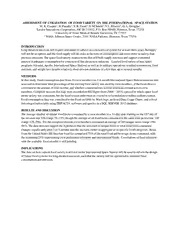
NASA Technical Reports Server (NTRS) 20170009420: Assessment of Utilization of Food Variety on the International Space Station PDF
Preview NASA Technical Reports Server (NTRS) 20170009420: Assessment of Utilization of Food Variety on the International Space Station
ASSESSMENT OF UTILIZATION OF FOOD VARIETY ON THE INTERNATIONAL SPACE STATION M. R. Cooper1, R. Paradis1, S. R. Zwart2, S. M Smith3, V.L. Kloeris3, G. L. Douglas3 1Leidos Innovations Corporation, JSC B17/1032, P.O. Box 58980, Houston, Texas 77258 2 University of Texas Medical Branch, Galveston, TX 77555 3 NASA Johnson Space Center, 2101 NASA Parkway, Houston, Texas 77058 INTRODUCTION Long duration missions will require astronauts to subsist on a closed food system for at least three years. Resupply will not be an option, and the food supply will be older at the time of consumption and more static in variety than previous missions. The space food variety requirements that will both supply nutrition and support continued interest in adequate consumption for a mission of this duration is unknown. Limited food variety of past space programs (Gemini, Apollo, International Space Station) as well as in military operations resulted in monotony, food aversion, and weight loss despite relatively short mission durations of a few days up to several months. METHODS In this study, food consumption data from 10 crew members on 3-6-month International Space Station missions was assessed to determine what percentage of the existing food variety was used by crew members, if the food choices correlated to the amount of time in orbit, and whether commonalities in food selections existed across crew members. Complete mission diet logs were recorded on ISS flights from 2008 – 2014, a period in which space food menu variety was consistent, but the food system underwent an extensive reformulation to reduce sodium content. Food consumption data was correlated to the Food on Orbit by Week logs, archived Data Usage Charts, and a food list categorization table using TRIFACTA software and queries in a SQL SERVER 2012 database. RESULTS AND DISCUSSION The average number of unique food items consumed by a crew member in a 14-day span starting on the 15th day of the mission was 106 (range 78-133), though the average of all food items consumed in the same time period was 220 (range 128-294). For the complete mission, crew members consumed an average of 265 unique items (range 196- 401). The data does not support the hypothesis that the selection of unique items or total food items consumed changes significantly after 3 or 5 months into the mission, either in aggregate or in specific food categories. Items from the United States ISS baseline food list comprised 75% of the total food and beverage items consumed, with the remaining 25% representing crew preference selections and international foods. Correlations of food selection with the available food on orbit is still pending. IMPLICATIONS The data on how current food variety is utilized on the International Space Station will be used to inform the design of future food systems for long duration missions, such that the variety will be optimized to maintain food consumption and nutrition.
